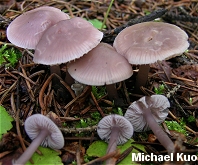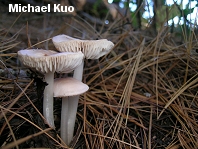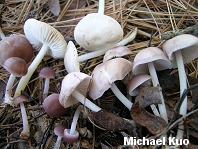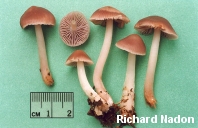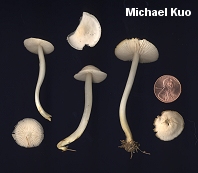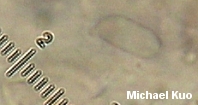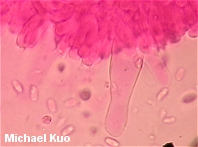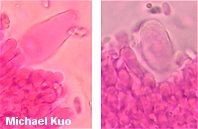| Major Groups > Gilled Mushrooms > Pale-Spored > Mycenoid Mushrooms > Mycena pura |

|
Mycena pura [ Basidiomycetes > Agaricales > Tricholomataceae > Mycena . . . ] by Michael Kuo One of the most beautiful species of Mycena, this widely distributed mushroom is found decomposing forest litter under conifers (and occasionally under hardwoods) across North America. It features a strong, radishlike odor and taste, and a cap that is convex, flat, or broadly bell-shaped at maturity. The colors of this species are extremely variable. When young and fresh, there is almost always lilac or purple involved--but as the mushroom matures other hues may predominate. White or yellowish specimens are often encountered, as well as pink, pinkish brown, and even reddish specimens. Specimens with purely pink caps and pinkish gills are sometimes referred to as Mycena rosea. Alexander Smith, who usually delights in meticulously recording varieties of species, gives up entirely in his treatment of Mycena in North America (1947); in a rare "lump" (as opposed to a "split"), he writes that "although one quickly learns to recognize the species, he soon gives up trying to distinguish any subdivisions of it." It is probable that DNA studies, once focused on Mycena in detail, will divide what is now known as "Mycena pura" into several phylogenetic species. Description: Ecology: Saprobic on forest debris under hardwoods and conifers; growing alone, scattered, or gregariously; terrestrial; widely distributed; spring, summer and fall (also in winter in California). Cap: 2-6 cm; convex or bell-shaped, becoming flattened; the margin lined; bald; moist or dry; typically lilac to purple when young, but often fading or developing other shades (including whitish, yellowish, pinkish brown or reddish). Gills: Attached to the stem by a tooth; close or nearly distant; whitish or sometimes slightly pinkish to purplish; developing cross-veins with maturity. Stem: 4-10 cm long; 2-6 mm thick; equal; hollow; smooth or with tiny hairs; whitish or flushed with the cap color. Flesh: Insubstantial; watery grayish to whitish. Odor and Taste: Odor radishlike or sometimes lacking; taste strongly radishlike. Chemical Reactions: KOH negative or greenish yellow on cap surface. Spore Print: White. Microscopic Features: Spores 6-10 x 3-4 µ; long-elliptical or nearly cylindrical; faintly to moderately amyloid, or inamyloid when mature; smooth. Basidia 4-spored. Cheilo- and pleurocystidia rare to scattered or abundant; 40-70 x 10-20 µ; fusoid-ventricose, widely fusiform, or saccate. REFERENCES: (Persoon, 1794) Kummer, 1871. (Fries, 1821; Saccardo, 1887; Kauffman, 1918; Smith, 1947; Smith, Smith & Weber, 1979; Arora, 1986; States, 1990; Phillips, 1991/2005; Lincoff, 1992; Evenson, 1997; Barron, 1999; Roody, 2003; McNeil, 2006; Miller & Miller, 2006.) Herb. Kuo 08170306, 10300401, 11050402, 10120903, 09241101. This site contains no information about the edibility or toxicity of mushrooms. |
© MushroomExpert.Com |
|
Cite this page as: Kuo, M. (2010, December). Mycena pura. Retrieved from the MushroomExpert.Com Web site: http://www.mushroomexpert.com/mycena_pura.html |
